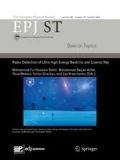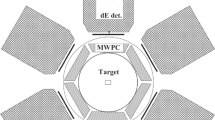Abstract
The pion–nucleon sigma term is a quantity involved in many important aspects of particle and nuclear physics. In this review, I show its origin and how it is connected to important questions as the origin of mass of the ordinary matter, studies of dark matter detection and nucleosynthesis. I mention the most common methods used to obtain the sigma term, and comment on the extracted values. As it is shown, the accepted value of the sigma term has been moving from relatively low (\(\sim 40\) MeV) to larger ones (\(\sim 60\) MeV) until today, where this controversy still persist.





Similar content being viewed by others
Notes
In the previous equation the \(2 m_N\) in the denominator appears because I used the normalization \(\langle N(p')| N(p)\rangle = (2\pi )^3 2E\, \delta ({\mathbf {p}\,' - \mathbf {p}})\), what will be customary for the rest of the article. Notice also that \(\hat{m}\) arises because we are working in the SU(2) symmetric limit.
Note that the \(1/2m_N\) factor comes from the normalization of the nucleon states.
The other matrix element, \(\langle N(p) | m_s\bar{s}s | N(p)\rangle \) can be estimated with the help of \(\sigma _{\pi N}\), as is shown later.
Only in a relativistic formulation of chiral EFT with baryons the analytic structure is completely preserved. However, since the problematic parts in non-relativistic approaches are the Born terms, and they are subtracted in the Cheng-Dashen theorem, one can still apply it in these versions of the EFT.
The last equality is valid only in a two-flavor approach.
In this section, t refers always to time.
The author provides the value of \(\varSigma \). This number considers the reduction by \(\varDelta _\sigma \).
References
S.L. Adler, Phys. Rev. 137, B1022–B1033 (1965)
S.L. Adler, Phys. Rev. 139, B1638–B1643 (1965)
S. Weinberg, Phys. Rev. Lett. 17, 616–621 (1966)
M. Gell-Mann, R.J. Oakes, B. Renner, Phys. Rev. 175, 2195–2199 (1968)
E. Reya, Rev. Mod. Phys. 46, 545–580 (1974)
S. Fubini, G. Furlan, Ann. Phys. 48, 322–365 (1968)
T.P. Cheng, R.F. Dashen, Phys. Rev. Lett. 26, 594 (1971)
L.S. Brown, W.J. Pardee, R.D. Peccei, Phys. Rev. D 4, 2801–2810 (1971)
V. Bernard, N. Kaiser, U.G. Meissner, Phys. Lett. B 389, 144–148 (1996)
H. Pagels, W.J. Pardee, Phys. Rev. D 4, 3335–3337 (1971)
R.J. Crewther, Phys. Rev. Lett. 28, 1421 (1972)
M.S. Chanowitz, J.R. Ellis, Phys. Lett. B 40, 397–400 (1972)
J.C. Collins, A. Duncan, S.D. Joglekar, Phys. Rev. D 16, 438–449 (1977)
M.A. Shifman, A.I. Vainshtein, V.I. Zakharov, Phys. Lett. B 78, 443–446 (1978)
R.J. Hill, M.P. Solon, Phys. Lett. B 707, 539–545 (2012)
A. Crivellin, M. Hoferichter, M. Procura, Phys. Rev. D 89, 054021 (2014)
A. Bottino, F. Donato, N. Fornengo, S. Scopel, Astropart. Phys. 18, 205–211 (2002)
A. Bottino, F. Donato, N. Fornengo, S. Scopel, Phys. Rev. D 78, 083520 (2008)
J.R. Ellis, K.A. Olive, C. Savage, Phys. Rev. D 77, 065026 (2008)
S. Elhatisari, N. Li, A. Rokash, J. M. Alarcón, D. Du, N. Klein, B. n. Lu, U. G. Meißner, E. Epelbaum and H. Krebs, et al. Phys. Rev. Lett. 117, no.13, 132501 (2016)
J.C. Berengut, E. Epelbaum, V.V. Flambaum, C. Hanhart, U.G. Meissner, J. Nebreda, J.R. Pelaez, Phys. Rev. D 87(8), 085018 (2013)
W. Weise, Prog. Part. Nucl. Phys. 67, 299–311 (2012)
N. Kaiser, P. de Homont, W. Weise, Phys. Rev. C 77, 025204 (2008)
J.A. Oller, Phys. Rev. C 65, 025204 (2002)
U.G. Meissner, J.A. Oller, A. Wirzba, Ann. Phys. 297, 27–66 (2002)
J.A. Oller, A. Lacour, U.G. Meissner, J. Phys. G 37, 015106 (2010)
A. Lacour, J.A. Oller, U.G. Meissner, J. Phys. G 37, 125002 (2010)
A. Lacour, J.A. Oller, U.G. Meissner, Ann. Phys. 326, 241–306 (2011)
J.A. Oller, J. Phys. G 46(7), 073001 (2019)
J.M. Alarcon, J. Martin Camalich, J.A. Oller, Phys. Rev. D 85, 051503 (2012)
J.M. Alarcon, L.S. Geng, J. Martin Camalich, J.A. Oller, Phys. Lett. B 730, 342–346 (2014)
I.P. Fernando, J.M. Alarcon, J.L. Goity, Phys. Lett. B 781, 719–722 (2018)
T.P. Cheng, Phys. Rev. D 13, 2161 (1976)
Y. Ne’eman, Nucl. Phys. 26, 222–229 (1961)
M. Gell-Mann, Phys. Rev. 125, 1067–1084 (1962)
M. Gell-Mann, Physics Physique Fizika 1, 63–75 (1964)
F. Von Hippel, J.K. Kim, Phys. Rev. D 1, 151–164 (1970). erratum: Phys. Rev. D3, 2923-2923 (1971)
J. Gasser, H. Leutwyler, M.P. Locher, M.E. Sainio, Phys. Lett. B 213, 85–90 (1988)
J. Gasser, H. Leutwyler, M.E. Sainio, Phys. Lett. B 253, 260–264 (1991)
J.A. Oller, L. Roca, Phys. Lett. B 651, 139–146 (2007)
J.F. Donoghue, J. Gasser, H. Leutwyler, Nucl. Phys. B 343, 341–368 (1990)
J. Gasser, H. Leutwyler, M.E. Sainio, Phys. Lett. B 253, 252–259 (1991)
M. Hoferichter, J. Ruiz de Elvira, B. Kubis, U.G. Meißner, Phys. Rev. Lett. 115, 092301 (2015)
T. Becher, H. Leutwyler, Eur. Phys. J. C 9, 643–671 (1999)
G. Altarelli, N. Cabibbo, L. Maiani, Phys. Lett. B 35, 415–418 (1971)
M.G. Olsson, E.T. Osypowski, J. Phys. G 6, 423 (1980)
M.G. Olsson, Phys. Lett. B 482, 50–56 (2000)
D. Gotta, F. Amaro, D.F. Anagnostopoulos, S. Biri, D.S. Covita, H. Gorke, A. Gruber, M. Hennebach, A. Hirtl, T. Ishiwatari et al., Lect. Notes Phys. 745, 165–186 (2008)
V. Baru, C. Hanhart, M. Hoferichter, B. Kubis, A. Nogga, D.R. Phillips, Nucl. Phys. A 872, 69–116 (2011)
J. Gasser, H. Leutwyler, Phys. Lett. B 125, 325–329 (1983)
J. Gasser, H. Leutwyler, Ann. Phys. 158, 142 (1984)
J. Gasser, H. Leutwyler, Nucl. Phys. B 250, 465–516 (1985)
J.M. Alarcon, J. Martin Camalich, J.A. Oller, Ann. Phys. 336, 413–461 (2013)
P. Güttinger, Das verhalten von atomen im magnetischen drehfeld. Zeitschrift für Physik 73, 169–184 (1932)
W. Pauli, Principles of Wave Mechanics, vol. 24 (Springer, New York, 1933), p. 162
H. Hellmann, Einführung in die Quantenchemie (Franz Deuticke, 1937) p. 285, OL21481721M
R.P. Feynman, Forces in molecules. Phys. Rev. 56, 340–343 (1939)
A. Abdel-Rehim et al., [ETM]. Phys. Rev. Lett. 116(25), 252001 (2016)
S. Durr, Z. Fodor, C. Hoelbling, S.D. Katz, S. Krieg, L. Lellouch, T. Lippert, T. Metivet, A. Portelli, K.K. Szabo et al., Phys. Rev. Lett. 116(17), 172001 (2016)
Y.B. Yang et al., [xQCD]. Phys. Rev. D 94(5), 054503 (2016)
G.S. Bali et al., [RQCD]. Phys. Rev. D 93(9), 094504 (2016)
C. Alexandrou, M. Constantinou, P. Dimopoulos, R. Frezzotti, K. Hadjiyiannakou, K. Jansen, C. Kallidonis, B. Kostrzewa, G. Koutsou, M. Mangin-Brinet et al., Phys. Rev. D 95(11), 114514 (2017). erratum: Phys. Rev. D 96, no.9, 099906 (2017)
S. Borsanyi, Z. Fodor, C. Hoelbling, L. Lellouch, K. K. Szabo, C. Torrero, L. Varnhorst. arXiv:2007.03319 [hep-lat]
E. Friedman, A. Gal, Phys. Lett. B 792, 340–344 (2019)
G. Hoehler, H.P. Jakob, R. Strauss, Phys. Lett. B 35, 445–449 (1971)
G. Hoehler, H.P. Jakob, R. Strauss, Nucl. Phys. B 39, 237–266 (1972)
H. Nielsen, G.C. Oades, Nucl. Phys. B 72, 310–320 (1974)
G.E. Hite, R.J. Jacob, Phys. Lett. B 53, 200–202 (1974)
W. Langbein, Nucl. Phys. B 94, 519–547 (1975)
Y.A. Chao, R.E. Cutkosky, R.L. Kelly, J.W. Alcock, Phys. Lett. B 57, 150–154 (1975)
J. Gasser, Ann. Phys. 136, 62 (1981)
R. Koch, Z. Phys. C 15, 161–168 (1982)
J. Gasser, M.E. Sainio, A. Svarc, Nucl. Phys. B 307, 779–853 (1988)
N. Fettes, U.G. Meissner, S. Steininger, Nucl. Phys. A 640, 199–234 (1998)
N. Fettes, U.G. Meissner, Nucl. Phys. A 679, 629–670 (2001)
M.M. Pavan, I.I. Strakovsky, R.L. Workman, R.A. Arndt, PiN Newslett. 16, 110–115 (2002)
H. Leutwyler, PoS CD15, 022 (2015)
J. Ruiz de Elvira, M. Hoferichter, B. Kubis, U.G. Meißner, J. Phys. G 45(2), 024001 (2018)
Author information
Authors and Affiliations
Corresponding author
Rights and permissions
About this article
Cite this article
Alarcón, J.M. Brief history of the pion–nucleon sigma term. Eur. Phys. J. Spec. Top. 230, 1609–1622 (2021). https://doi.org/10.1140/epjs/s11734-021-00145-6
Received:
Accepted:
Published:
Issue Date:
DOI: https://doi.org/10.1140/epjs/s11734-021-00145-6




